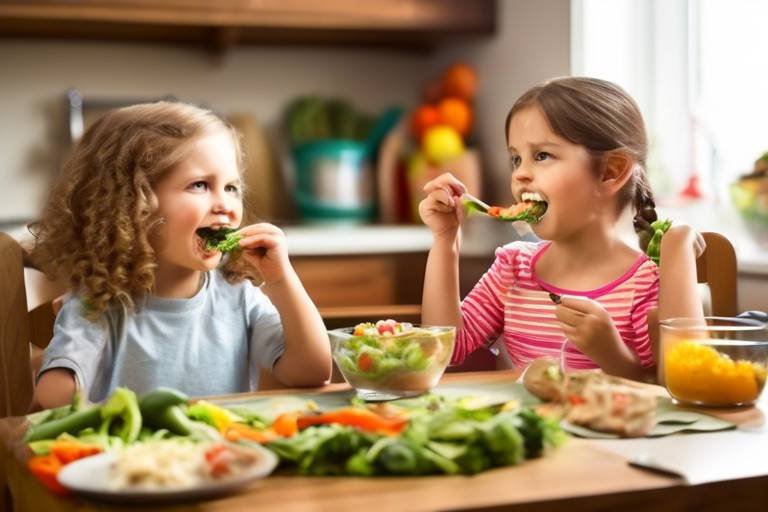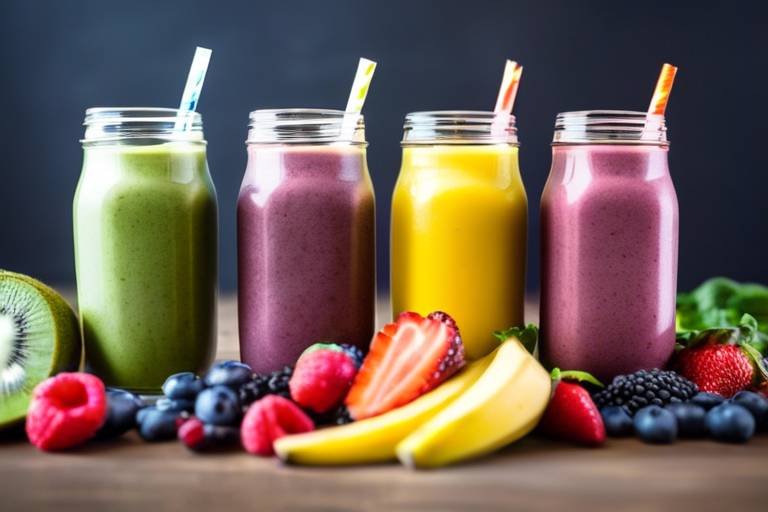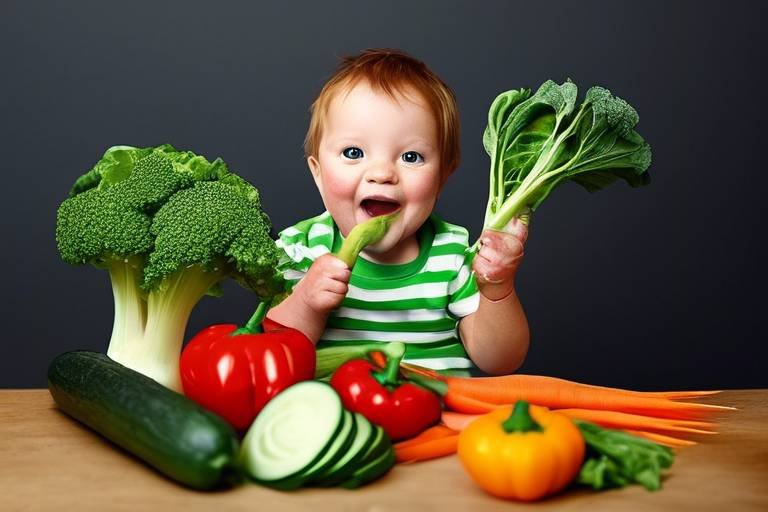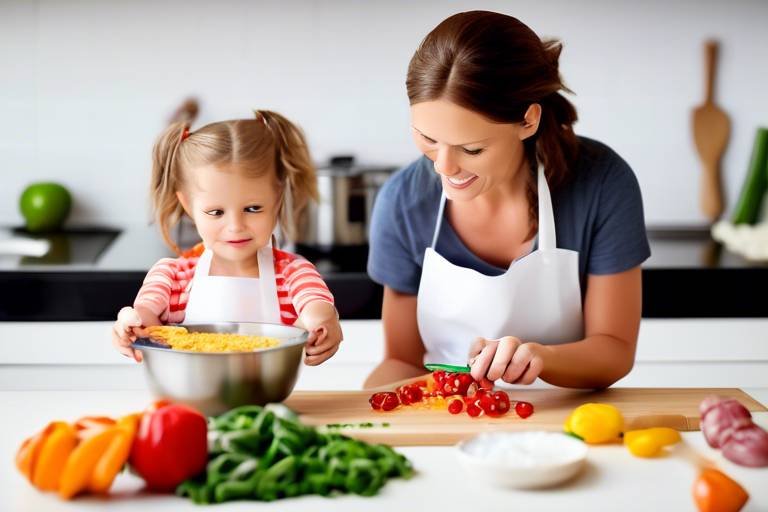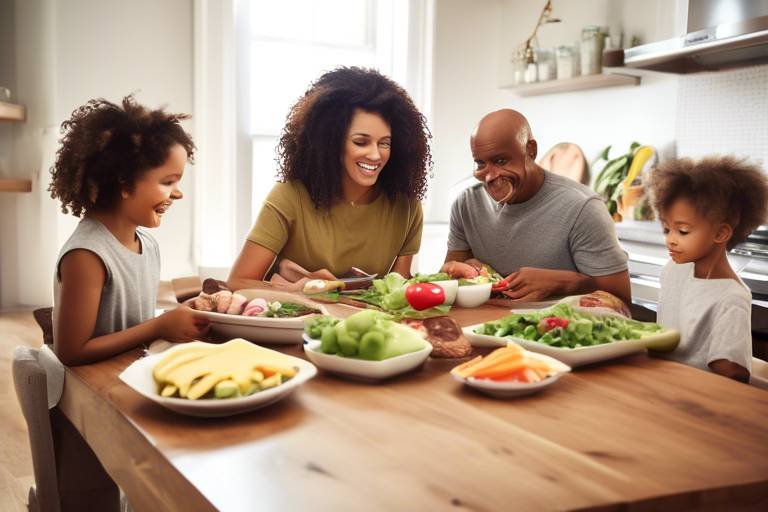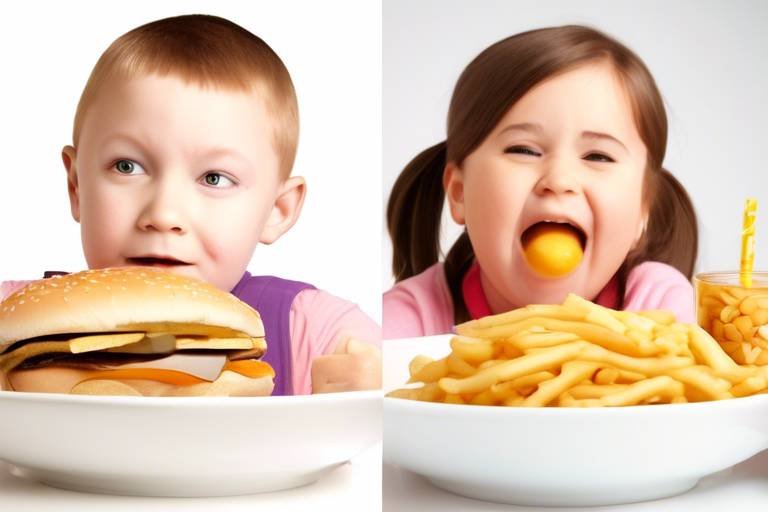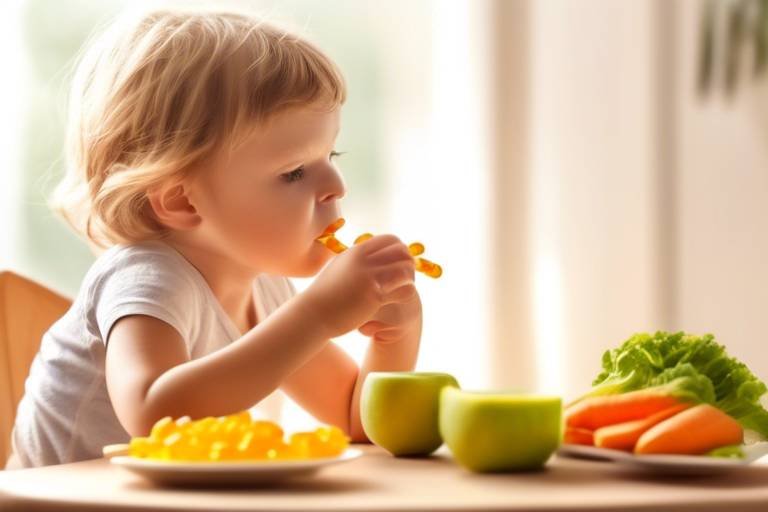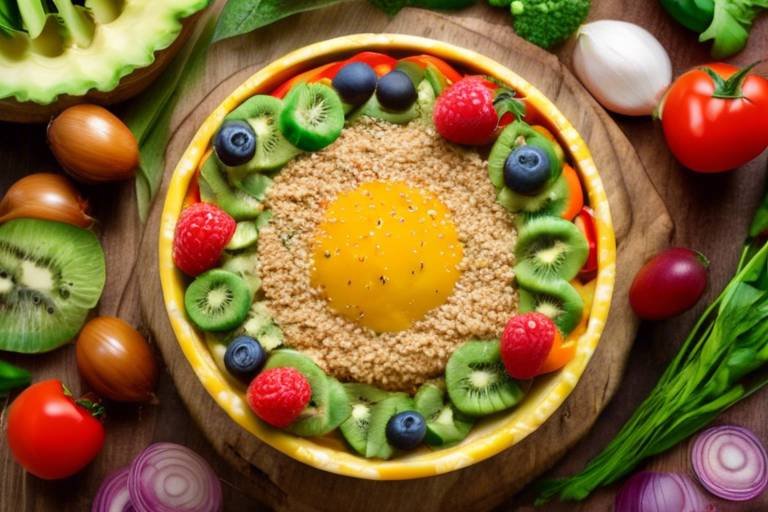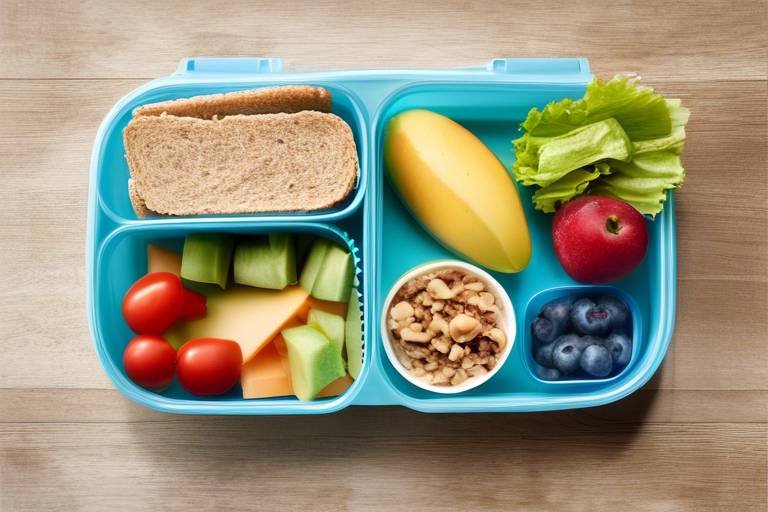Making Nutritious Pizza That Your Kids Will Love
Are you tired of the same old pizza night routine? You’re not alone! Many parents face the challenge of creating meals that are both nutritious and appealing to their little ones. But here’s the good news: making healthy pizzas that your kids will love can be both fun and simple! In this article, we’ll explore creative ways to prepare delicious pizzas that not only satisfy your children's taste buds but also pack in essential nutrients.
Imagine a pizza night where your kids are not just eating, but also learning about healthy food choices! With the right ingredients and a little creativity, you can transform pizza from a guilty pleasure into a wholesome meal. So, let’s dive into the world of nutritious pizzas, starting with the foundation: the pizza base.
The base of your pizza is crucial—it sets the stage for everything that follows. You have a variety of options to choose from, each offering unique health benefits. For instance, whole wheat crust is a fantastic choice, as it adds fiber and nutrients while still delivering that satisfying crunch. Alternatively, if you want to sneak in some veggies, consider using a cauliflower crust. It’s low in carbs and high in vitamins, making it a great option for health-conscious families.
Here’s a quick comparison of popular pizza bases:
| Pizza Base | Health Benefits | Flavor Profile |
|---|---|---|
| Whole Wheat | High in fiber, more nutrients | Nutty and hearty |
| Cauliflower | Low in carbs, rich in vitamins | Light and slightly sweet |
| Chickpea Flour | High in protein, gluten-free | Earthy and savory |
Next up is the sauce! Traditional pizza sauces can often be loaded with sugar and preservatives, which isn't ideal for our little ones. Instead, consider making your own sauce at home. A simple homemade tomato sauce using fresh tomatoes, garlic, and herbs can be both delicious and nutritious. Alternatively, pesto made from basil, nuts, and olive oil can add a burst of flavor while providing healthy fats and antioxidants.
Now, let’s talk toppings! This is where you can really get creative and make the pizza visually appealing. A colorful pizza is not only more enticing but also ensures a variety of nutrients. Think about incorporating a mix of vegetables, lean proteins, and even fruits! For example, you can add:
- Vegetables: Bell peppers, spinach, zucchini, and even sweet corn can add color and crunch.
- Proteins: Grilled chicken, turkey slices, or plant-based options like chickpeas can enhance the pizza's nutritional profile.
- Fruits: Pineapple or sliced apples can provide a sweet twist that kids might love!
Adding vegetables to pizza not only boosts its nutritional value but also introduces kids to new flavors. You can try roasting veggies like zucchini or bell peppers to enhance their sweetness, making them more appealing to young taste buds. Remember, the more colorful the pizza, the more likely kids are to be excited about it!
Including proteins like chicken, turkey, or even plant-based alternatives can enhance the pizza's nutritional profile. You might want to try shredded chicken or turkey pepperoni, which are both kid-friendly and tasty. For a vegetarian option, consider adding some black beans or lentils, which are packed with protein and fiber!
One of the best ways to get kids interested in healthy eating is to involve them in the cooking process. Pizza-making is a perfect opportunity for this! Let them roll the dough, spread the sauce, and choose their toppings. This not only makes the meal more interactive but also gives them a sense of ownership over what they’re eating.
Turn pizza night into a fun learning experience! As you prepare the meal, take the time to chat with your kids about nutrition. You can explain the benefits of each ingredient, discuss food groups, and emphasize the importance of healthy eating. It’s a wonderful way to combine fun and education, making mealtime enjoyable and informative.
After a fun pizza night, you might find yourself with some leftovers. Proper storage and reheating methods can help maintain the pizza's taste and texture. Store the pizza in an airtight container in the fridge, and when it’s time to reheat, consider using an oven or toaster oven to keep the crust crispy. This way, you can minimize waste while ensuring that your family enjoys every last bite!
- Can I make pizza dough ahead of time? Yes! You can prepare the dough in advance and freeze it. Just thaw it in the fridge before using.
- What are some good gluten-free options? Cauliflower crust or chickpea flour crusts are great gluten-free alternatives.
- How can I make pizza more appealing to picky eaters? Try using fun shapes for the crust or toppings and involve them in the preparation process!

Choosing the Right Base
When it comes to making a pizza that your kids will love, the base is the unsung hero. Choosing the right base is crucial, as it sets the stage for the entire meal. Think of it as the canvas for a masterpiece; if the canvas isn’t right, the painting won’t shine. Luckily, there are several nutritious options that not only taste great but also provide essential nutrients your kids need to grow strong and healthy.
One popular choice is whole wheat crust. This option is packed with fiber, which is great for digestion and keeps kids feeling full longer. Whole wheat flour is less processed than white flour, meaning it retains more nutrients. Plus, it has a nutty flavor that can make even the pickiest eaters go "Mmm!" But if your kids are feeling adventurous, you might want to try a cauliflower crust. This gluten-free alternative is not only low in carbs but also a fantastic way to sneak in some extra veggies. Imagine serving a pizza that tastes amazing and is made with vegetables—how cool is that?
For those who want to go even further, there are chickpea flour crusts or almond flour crusts. These options are rich in protein and healthy fats, making them perfect for a balanced meal. Here’s a quick comparison of some popular pizza bases:
| Pizza Base | Key Benefits | Flavor Profile |
|---|---|---|
| Whole Wheat Crust | High in fiber, nutritious | Nutty, hearty |
| Cauliflower Crust | Low-carb, gluten-free | Light, slightly sweet |
| Chickpea Flour Crust | High in protein, gluten-free | Earthy, rich |
| Almond Flour Crust | Low-carb, healthy fats | Nutty, slightly sweet |
But hold on! It’s not just about the health benefits; kids also need to enjoy what they’re eating. So, how do you make these nutritious bases appealing? Consider letting your kids customize their own pizzas. Set up a pizza-making station with different bases and toppings. This way, they can choose what they want, making them more likely to eat—and love—their creation. You might be surprised to find that they’ll be more adventurous when they have a hand in the process!
In summary, whether you opt for whole wheat, cauliflower, chickpea, or almond flour, the right base can transform your pizza night into a fun and healthy experience. So, roll up your sleeves, gather the family, and get ready to create a pizza masterpiece that everyone will love!

Healthy Sauce Alternatives
When it comes to pizza, the sauce is a game-changer. Traditional pizza sauces can often be packed with sugar and preservatives, which can turn a nutritious meal into a sugary treat. But fear not! There are plenty of healthy alternatives that can elevate your pizza's flavor while keeping it nutritious. One of the best options is to make your own homemade tomato sauce. This way, you can control the ingredients and avoid any hidden sugars. Simply blend fresh tomatoes with garlic, basil, and a splash of olive oil for a vibrant and tasty sauce that kids will love.
Another fantastic alternative is pesto. This green sauce, made from basil, garlic, pine nuts, and olive oil, is not only delicious but also packed with nutrients. You can even sneak in some spinach or kale to boost the nutritional value without altering the flavor too much. Plus, kids often enjoy the bright green color and the unique taste it brings to their pizza.
If you're looking for something a bit different, consider a white sauce made from Greek yogurt or ricotta cheese. This creamy option can be a hit with kids, and you can add herbs like oregano or thyme for extra flavor. It’s a great way to introduce more calcium into their diet while still enjoying their favorite food.
Here’s a quick comparison of these sauces:
| Sauce Type | Main Ingredients | Health Benefits |
|---|---|---|
| Homemade Tomato Sauce | Fresh tomatoes, garlic, basil, olive oil | Low in sugar, high in vitamins A and C |
| Pesto | Basil, garlic, pine nuts, olive oil | Rich in healthy fats, vitamins, and antioxidants |
| White Sauce | Greek yogurt or ricotta, herbs | High in protein and calcium |
By choosing these healthier sauce alternatives, you’re not just making a pizza; you’re creating a nutritional powerhouse that your kids will adore. Plus, involving them in the sauce-making process can be a fun way to teach them about cooking and nutrition. So, roll up your sleeves, grab the ingredients, and let the sauce-making begin!
- Can I use store-bought sauces? Yes, just look for options that are low in sugar and free from preservatives.
- How can I make my sauce more flavorful? Experiment with herbs and spices like oregano, thyme, or even a pinch of red pepper flakes for extra kick!
- Are there any sauces I should avoid? Try to avoid sauces with high fructose corn syrup and artificial ingredients.

Creative Topping Ideas
When it comes to making pizza that kids will love, the toppings are where the magic happens! Just like a painter adds splashes of color to a canvas, you can transform a simple pizza into a vibrant masterpiece that not only looks appealing but is also packed with nutrition. The key is to think outside the box and incorporate a variety of ingredients that will excite young taste buds. Imagine a pizza topped with a rainbow of vegetables, lean proteins, and even some unexpected fruits! Yes, you heard that right—fruits can be a delightful addition to your pizza.
Start by considering the vegetable toppings. You might think that kids are picky, but introducing them to new flavors can be a game changer. For instance, bell peppers come in various colors, making them visually appealing. Spinach is not only nutritious but can also blend seamlessly into the cheese, making it almost invisible to the untrained eye. Zucchini, when sliced thinly, adds a nice texture and mild flavor that most kids will enjoy. The secret is to make the vegetables fun! You can cut the veggies into shapes using cookie cutters or arrange them in a smiley face pattern to make the pizza more inviting.
Next, let’s talk about protein options. Adding proteins like grilled chicken or turkey can elevate your pizza from a snack to a satisfying meal. But don’t stop there! Consider plant-based proteins like chickpeas or black beans for a healthy twist. You can even make a “meat lovers” pizza with lean ground turkey or shredded chicken, which can be seasoned with kid-friendly spices to enhance the flavor without overwhelming their palates. Remember, the goal is to create a pizza that is not just nutritious but also delicious, so get creative with how you present these proteins on the pizza!
Now, here’s where it gets really fun—think about adding fruits as toppings! Pineapple is a classic choice, but you can also experiment with sliced apples, pears, or even figs. The sweetness of the fruit can balance out the savory flavors of the cheese and sauce, creating a delightful contrast that kids might just love. A drizzle of balsamic glaze over the top can add a gourmet touch that makes the pizza feel special.
To help you visualize these creative topping ideas, here’s a simple table that outlines some combinations that are sure to please:
| Topping Type | Examples | Benefits |
|---|---|---|
| Vegetables | Bell Peppers, Spinach, Zucchini | Packed with vitamins and minerals, adds color |
| Proteins | Grilled Chicken, Turkey, Chickpeas | Enhances satiety, builds muscle |
| Fruits | Pineapple, Apples, Figs | Natural sweetness, adds fiber |
In conclusion, the toppings you choose can make all the difference in creating a pizza that your kids will not only eat but will also enjoy. By mixing and matching vegetables, proteins, and even fruits, you can create a deliciously unique pizza that’s as nutritious as it is fun. So grab those toppings and get ready to make pizza night an exciting culinary adventure!
Q1: Can I use frozen vegetables as toppings?
A1: Absolutely! Frozen vegetables are a great option and can be just as nutritious as fresh ones. Just make sure to thaw and drain them before adding them to your pizza.
Q2: What if my kids don’t like vegetables?
A2: Try introducing vegetables gradually and in fun ways, like using cookie cutters to create shapes or blending them into the sauce. You can also let them choose their own toppings to make it more engaging.
Q3: How can I make pizza night more interactive?
A3: Consider setting up a pizza bar where kids can choose their own toppings. This not only makes them more excited about eating but also teaches them about making healthy choices.

Vegetable Toppings
Adding vegetables to your pizza is like inviting a colorful parade to your dinner plate! Not only do they enhance the visual appeal, but they also significantly boost the nutritional value of the meal. Kids can be picky eaters, but with the right approach, you can introduce them to a world of flavors that they might not have considered before. Think of vegetables as the superheroes of your pizza, bringing essential vitamins and minerals to the table while keeping it delicious and fun.
Start with vibrant options like bell peppers, which come in a rainbow of colors. Their crisp texture and natural sweetness can make even the most stubborn veggie-hater reconsider. You can slice them thinly and let your kids help sprinkle them on top of the sauce. Next up, spinach! This leafy green is not only packed with iron but also adds a lovely pop of green that can make your pizza look like a work of art. Sauté it lightly before adding it to the pizza to enhance its flavor and make it a bit more palatable for young eaters.
Don't forget about zucchini! This versatile vegetable can be sliced into thin rounds or even spiraled for a fun twist. When roasted, zucchini becomes tender and flavorful, making it a perfect topping that kids will love. You might also want to consider adding some mushrooms—they provide a meaty texture and a rich, umami flavor that can satisfy even the pickiest of eaters.
For a touch of sweetness, why not try caramelized onions? Their natural sugars come out when cooked, creating a delicious topping that can surprise your kids. And if you’re feeling adventurous, consider adding some pineapple or sweet corn for a fruity twist. Both options can introduce a delightful sweetness that pairs beautifully with savory elements.
Here’s a quick overview of some kid-friendly vegetable toppings to consider:
| Vegetable | Benefits | Preparation Tips |
|---|---|---|
| Bell Peppers | Rich in Vitamin C | Slice thinly for easy handling |
| Spinach | High in Iron and Vitamins | Sauté lightly to enhance flavor |
| Zucchini | Low in Calories, High in Nutrients | Slice or spiralize for fun shapes |
| Mushrooms | Provides Umami Flavor | Slice and sauté for best taste |
| Caramelized Onions | Natural Sweetness | Cook slowly to bring out sugars |
Incorporating these vegetables into your pizza not only makes it a healthier choice but also turns meal prep into a fun family activity. Encourage your kids to choose their favorite vegetables and let them experiment with combinations. Who knows? They might just discover a new favorite topping along the way!

Protein Options
When it comes to making nutritious pizza, one of the key components is ensuring that you're incorporating a variety of protein sources. Not only do proteins help in building and repairing tissues, but they also play a crucial role in keeping our kids feeling full and satisfied. So, what are some great protein options that can easily be added to your homemade pizza without compromising on taste? Let's dive in!
First off, consider lean meats such as grilled chicken or ground turkey. These options are not only delicious but also lower in fat compared to traditional pepperoni or sausage. You can marinate the chicken in some herbs and spices before grilling it, giving it a flavorful kick that kids will love. Ground turkey can be seasoned similarly and sprinkled over the pizza for an extra boost of flavor.
If you're looking for plant-based alternatives, chickpeas or black beans can be fantastic additions. Not only do they provide protein, but they also add a unique texture to the pizza. You can mash them up and spread them as a base layer or simply sprinkle them on top with other toppings. Plus, beans are a great way to introduce more fiber into your kids' diets!
Another fun option is to use cheese—and not just the traditional mozzarella. Experiment with different types of cheese like feta, goat cheese, or even a sprinkle of parmesan to elevate the flavor profile. Cheese is not only a source of protein but also calcium, which is essential for growing bones.
For those who enjoy seafood, consider adding some shrimp or tuna. Shrimp can be quickly sautéed with garlic and herbs, making them a delightful topping that adds a bit of sophistication to your pizza night. Tuna, whether fresh or canned, can be mixed with a little mayonnaise and spread over the base for a unique twist.
Lastly, don't forget about the importance of involving your kids in the selection of protein options. By allowing them to choose their favorite toppings, you can create a sense of ownership and excitement about the meal. You might be surprised to find that they enjoy trying new proteins when they have a say in the process!
In summary, there are plenty of protein options to explore when making pizza. From lean meats and plant-based alternatives to various cheeses and seafood, the possibilities are endless. Each of these options not only enhances the flavor but also contributes to a balanced meal that your kids will adore. So, roll up your sleeves, get creative, and enjoy making a deliciously nutritious pizza together!
- What are the best protein options for kids' pizza? Lean meats like chicken and turkey, plant-based proteins like beans, and a variety of cheeses are excellent choices.
- Can I use frozen proteins on my pizza? Yes, frozen proteins like shrimp or chicken can be used, but make sure to cook them properly before adding them to the pizza.
- How can I make pizza more nutritious? Incorporate whole grain crusts, use homemade sauces, and load up on a variety of colorful vegetables and lean proteins.

Involving Kids in the Process
Getting kids involved in the pizza-making process is like adding a secret ingredient that transforms a regular meal into a delightful experience! When children participate in preparing their food, they become more curious and enthusiastic about trying new flavors and ingredients. It’s not just about making pizza; it’s about creating memories and fostering a love for healthy eating. Imagine the joy on their faces as they roll out the dough, sprinkle cheese, and choose their favorite toppings. This hands-on approach can turn a simple dinner into a fun family activity!
One of the best ways to involve kids is to set up a mini pizza station. You can lay out all the ingredients and let them pick and choose what they want on their pizza. This not only encourages creativity but also gives them a sense of ownership over their meal. You might be surprised to see them excited about trying spinach or bell peppers when they can select them themselves. Plus, it’s a fantastic opportunity to teach them about different food groups and the nutritional benefits of each topping. For example, you can explain how vegetables provide essential vitamins, while proteins help them grow strong.
Here are a few fun activities to engage your little chefs:
- Dough Rolling: Kids love to get their hands messy! Let them roll out the pizza dough, which can be a great way to develop fine motor skills.
- Topping Selection: Provide a variety of toppings and let them choose their favorites. You might even create a “topping bar” with colorful ingredients.
- Creative Shapes: Encourage them to use cookie cutters to create fun shapes with the dough. Who wouldn’t want a star-shaped pizza?
Additionally, you can turn this into an educational experience by discussing the origins of pizza or the different types of cheeses used. It can be fascinating for kids to learn that pizza has roots in Italy and that there are countless variations around the world. This knowledge can spark their interest in trying different cuisines, making mealtime an adventure.
Lastly, don’t forget to celebrate their creations! Once the pizzas are baked to perfection, sit down together and enjoy the fruits of their labor. You can even have a little taste test competition to see who made the best pizza. This not only makes the meal more enjoyable but also reinforces the idea that healthy eating can be both fun and rewarding. So, roll up your sleeves, gather your ingredients, and let the pizza-making fun begin!
Q: How can I make pizza-making more educational for my kids?
A: You can teach them about different food groups, the origins of pizza, and the nutritional benefits of the ingredients. Engage them in conversations about health and nutrition while cooking.
Q: What if my kids are picky eaters?
A: Involve them in the selection process and encourage them to try new toppings. You might be surprised at what they will eat when they have a hand in making it!
Q: Can I make pizza dough ahead of time?
A: Absolutely! You can prepare the dough in advance and store it in the fridge or freezer. This way, you can have a quick pizza night whenever you want!

Making it Fun and Educational
Transforming pizza night into a fun and educational experience can be a game-changer for both you and your kids. Imagine this: instead of just slapping toppings on dough, you turn the entire process into a mini-adventure. Kids love to explore, and what better way to do that than through food? You can start by discussing the different ingredients you’re using. For instance, when you pull out that vibrant red bell pepper, ask your little ones, “Do you know what vitamins are packed in this colorful veggie?” This not only piques their curiosity but also makes them more likely to eat it!
To make it even more engaging, you can introduce a pizza-making theme night. Each week could have a different theme, like “Tropical Paradise” where you use pineapple and ham, or “Garden Delight” featuring all kinds of veggies. This adds an element of surprise and excitement, keeping your kids looking forward to pizza night. You can even create a pizza passport, where they get a stamp for each new topping or theme they try. Talk about a fun way to encourage adventurous eating!
Incorporating some educational elements doesn’t have to feel like a chore. You can turn it into a game! For example, while preparing the pizza, challenge your kids to guess the number of calories in each ingredient or the amount of fiber in whole wheat crust versus regular crust. This not only teaches them about nutrition but also helps them develop critical thinking skills. You might be surprised at how much they enjoy these little challenges!
Don't forget about the importance of teamwork. Allow your kids to take on roles, whether it's as the “sauce spreader” or the “topping artist.” This way, they feel a sense of responsibility and ownership over what they’re creating. Plus, working together fosters a sense of family bonding that’s so important. You could even set up a little pizza competition where everyone makes their own unique pizza, and then you can vote on the most creative one. The winner gets to choose the next pizza night theme!
Lastly, consider using this opportunity to teach them about the food groups. While you’re layering on the cheese, explain how dairy is essential for strong bones. When you sprinkle on some spinach, talk about how leafy greens are packed with iron. This is a fantastic way to embed nutritional knowledge in a fun context. You could even create a simple chart to display the food groups and their benefits, making it a visual learning experience.
In summary, making pizza night a fun and educational experience isn't just about cooking; it's about creating lasting memories and instilling healthy habits. By engaging your kids in the process, you’re not only teaching them about nutrition but also giving them the tools to make better food choices in the future. So, roll up those sleeves, gather the ingredients, and let the pizza-making adventure begin!
- How can I get my kids to eat more vegetables on their pizza?
Involve them in the selection process and let them choose colorful veggies they want to try. - What are some easy alternatives to traditional pizza crust?
Consider using whole wheat, cauliflower, or even zucchini crusts for a healthier option. - Can pizza be a healthy meal?
Absolutely! By choosing nutritious ingredients and controlling portions, pizza can be both delicious and healthy. - How can I make pizza night more engaging for my kids?
Introduce themes, games, or competitions to keep the excitement alive!

Storing and Reheating Leftovers
When it comes to enjoying your homemade pizza days after the initial feast, proper storage and reheating are essential to maintain that delicious taste and texture. Nobody wants a soggy slice of pizza, right? So, let's dive into some smart strategies to keep your pizza as fresh as the day you made it!
First off, after your pizza night is over and you have some leftovers, let the pizza cool down to room temperature. This step is crucial because if you store it while it's still hot, condensation can accumulate inside the storage container, leading to that dreaded sogginess. Once cooled, you can wrap individual slices in plastic wrap or aluminum foil. Alternatively, you can place them in an airtight container. This will help keep the moisture in check and prevent the pizza from absorbing any unwanted odors from your fridge.
For longer storage, consider freezing your leftover pizza. Just make sure to wrap each slice tightly and place them in a freezer-safe bag or container. When properly stored, your pizza can last for up to three months in the freezer. Just remember to label the bag with the date so you can keep track of freshness. When you're ready to enjoy a slice, simply take it out of the freezer and let it thaw in the refrigerator overnight before reheating.
Now, onto the reheating part! One of the best ways to reheat pizza is in the oven. Preheat your oven to 375°F (190°C), then place the pizza slices directly on the oven rack or on a baking sheet. Bake for about 10-15 minutes, or until the cheese is bubbly and the crust is crispy again. This method not only revives the flavor but also restores that delightful crunch we all love.
If you're short on time, you can also use a microwave, but be cautious! Microwaving can make the crust chewy rather than crispy. To combat this, place a cup of water in the microwave alongside your pizza slice. The steam from the water helps keep the crust from getting too rubbery. Heat for about 30 seconds, then check if it’s warm enough. If not, add more time in short increments.
Lastly, if you're feeling adventurous, you can even use a skillet to reheat your pizza. Just place the slice in a preheated skillet over medium heat, cover it with a lid, and let it cook for about 5-8 minutes. This method helps to crisp up the bottom while melting the cheese perfectly.
In summary, whether you choose to store your pizza in the fridge or freezer, and however you decide to reheat it, the goal is to retain that mouthwatering flavor and texture. With these tips, you can enjoy your nutritious pizza even days later, minimizing waste and maximizing taste!
- How long can I store leftover pizza in the fridge? Leftover pizza can typically be stored in the fridge for about 3-4 days.
- Can I freeze pizza with toppings? Yes! Freezing pizza with toppings is perfectly fine, just make sure it’s well-wrapped.
- What’s the best way to reheat pizza? The oven is the best method for reheating pizza, as it helps restore the crust's crispiness.
- Can I reheat pizza more than once? It’s best to reheat only what you plan to eat to maintain quality, but if necessary, it can be reheated multiple times.
Frequently Asked Questions
- What are some nutritious pizza base options?
When it comes to choosing a pizza base, you have several nutritious options! Whole wheat crusts are rich in fiber, while cauliflower crusts are low in carbs and gluten-free. You can even experiment with chickpea flour or quinoa for a protein-packed alternative. Each of these bases offers a delicious flavor that kids will love!
- How can I make healthier pizza sauce?
To create a healthier pizza sauce, consider making your own! You can blend fresh tomatoes, garlic, and herbs for a tasty homemade tomato sauce. Alternatively, pesto made from basil, olive oil, and nuts is a fantastic option that adds a burst of flavor without the added sugars and preservatives found in store-bought sauces.
- What are some kid-friendly vegetable toppings?
Getting kids to eat their veggies can be a challenge, but choosing the right ones makes it easier! Colorful bell peppers, sweet corn, fresh spinach, and even zucchini can be fun and appealing. You can cut them into fun shapes or let the kids sprinkle them on themselves, making it a playful experience!
- Can I include proteins on my pizza?
Absolutely! Adding lean proteins like grilled chicken, turkey, or even plant-based options like beans or tofu can enhance the pizza's nutritional value. Not only do they provide essential nutrients, but they also make the pizza more filling, which is great for growing kids!
- How can I involve my kids in the pizza-making process?
Involving kids in making pizza can be a fun bonding experience! Let them help roll out the dough, spread the sauce, and choose their own toppings. This hands-on approach encourages them to try new foods and can turn dinner into a fun family activity!
- How can I make pizza night educational?
Pizza night is a perfect opportunity to teach kids about nutrition! Discuss the different food groups represented in their pizza, such as grains, vegetables, and proteins. You can even talk about the importance of healthy eating while enjoying your delicious creation together!
- What are the best ways to store and reheat pizza leftovers?
To keep your pizza fresh, store leftovers in an airtight container in the refrigerator. When reheating, try using an oven or a skillet to maintain that crispy crust. Microwaving can make it soggy, so avoid that if you can! Enjoying those leftovers can be just as delightful as the first meal!





